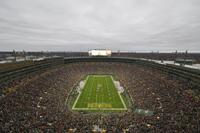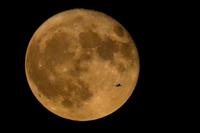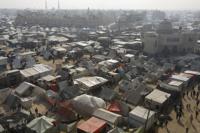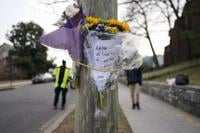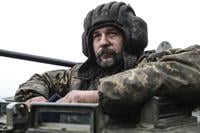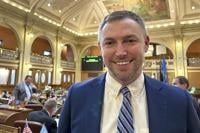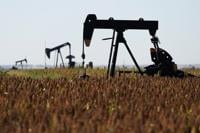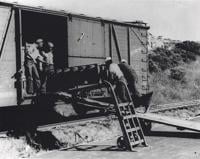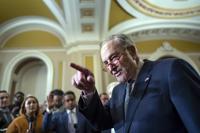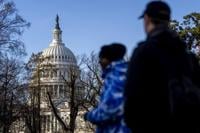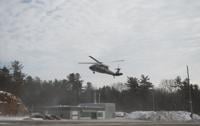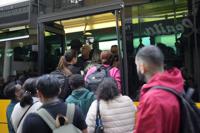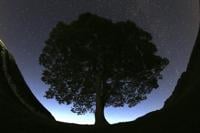GREEN BAY, Wis. (AP) — Corey Behnke was a 7-year-old attending a Green Bay Packers preseason game with his grandfather when he pointed to the homes across the street from Lambeau Field and vowed to live there eventually.
Now he has one of the best spots to watch as the NFL’s takes shape.
The NFL draft’s annual pilgrimage to cities across the league is next week with all the pageantry that comes from operating in the home of the NFL’s only publicly owned franchise.
“I think it’s going to be iconic in a way that other drafts aren’t,” said Behnke, now president of the neighborhood association of the area adjacent to Lambeau Field.
As soon as the NFL started taking its draft around the country nearly a decade ago, Packers officials wondered what it would take to bring the event to Green Bay. They realized they’d never get a Super Bowl because of Green Bay’s small population and frigid February weather.
Hosting a draft would be the next best thing.
The possibility that Packers president/CEO Mark Murphy envisioned so long ago now becomes reality just as he prepares for this summer. As draft-related construction continues in the area around Lambeau, one of several Packers-themed signs in the yards of homes across the street from the stadium includes this message: “Draft Dreams on Murphy’s Turf.”
“For us, we’d been seeing how the draft has grown and what it’s become, and knew the kind of impact it would have, not just on the local Green Bay community, but the entire state,” Murphy said. “Since we’re a community-owned team, that’s really one of our top priorities, is to give back to the community. It’ll be the largest event ever held in Green Bay.”
Therein lies the challenge.
The Green Bay metro area includes about 320,000 people, according to Discover Green Bay spokesman Nick Meisner. The city itself has a population of under 110,000. Bringing the draft to a town of this size creates obstacles that league officials didn’t have to worry about when this event took place in Chicago, Philadelphia or other major metro areas.
Green Bay has about 5,000 hotel rooms, a figure that gets up to 10,000 when nearby Appleton is included. That means plenty of fans watching the draft may have to stay a couple of hours away in Milwaukee or Madison, though many of them already are accustomed to doing that for Packers home games.
“When people say, can the city handle it, well, what does that mean?” Behnke asked. “Do we have enough hotels? No, but we knew that. Does Wisconsin have enough hotels? Yeah, I think so. I think a lot of people (understand) the fact that it’s going to be a driving event. People are going to drive here. But I also think that’s how games are. … I think people are kind of used to driving an hour-and-a-half or two hours to get to Green Bay.”
The smaller population likely means a smaller number of people at this draft. Murphy said a total attendance of about 250,000 is expected, less than one-third of the of over 775,000 that attended last year's draft in Detroit. Crowd figures are measured by adding the attendance numbers for each of the draft’s three days, so one person who attends all three days would be counted three times.
“The beauty of the draft is you can adapt it to any environment you’re in,” said Jon Barker, the NFL’s senior vice president for global event operations. “With each draft, there’s always going to be challenges that you need to overcome, but there’s also great opportunity.”
Those opportunities involve focusing on the tradition and history of a place Behnke calls “the best football town in America."
For instance, one of the NFL’s greatest training-camp rituals occurs at Green Bay each summer, as players borrow children’s bicycles to ride from the locker room to the practice field. Packers officials referenced this tradition in their draft bid by sending a Packers-themed bike to NFL Commissioner Roger Goodell’s office.
“We had our draft pitch in video form in the basket in the Packer bike,” said Gabrielle Dow, the Packers’ vice president of marketing and fan engagement.
Without giving too much away, Barker said part of Thursday’s draft opening will incorporate that bike tradition. A bike parade for children is planned for Saturday.
There are other local connections as well. When first-round picks hear their names called, they’ll go through a walkway featuring artwork from Milwaukee-based Ike Wynter, who will have made each of his pieces of reclaimed wood from discarded furniture collected across the state. Former Wisconsin Badgers such as Jonathan Taylor, Joe Thomas, Tim Krumrie and James White will be announcing picks on the draft’s second and third days.
Lambeau Field also will play a central role in this draft, though this sprawling event encompasses millions of square feet surrounding the stadium. Admission is free, and television screens all over the area will enable fans to watch the draft even if they’re far from the stage and taking in the NFL Draft Experience, a fan festival featuring games, exhibits, activities and autograph sessions.
When probable first-round selections make their red-carpet entrance Thursday before the draft, they’ll walk onto the field known for its Frozen Tundra nickname. Fans will be able to go into the stadium to watch the draft on the giant scoreboard. The stage on which the picks are announced is in a parking lot just east of Lambeau Field.
“I think it’ll be a three-day commercial not just for Green Bay but for the entire state,” Murphy said. “So many different things that are unique and special to Wisconsin, you’ll see that as a part of it.”
It also will showcase how much growth has taken place in the area around Lambeau Field.
The Resch Expo, a 125,000-square-foot facility just east of the stadium, opened in 2021 and will serve as the green room for draft prospects. The NFL Draft Experience will be at Titletown, a 45-acre development just west of Lambeau Field that features offices, shops, restaurants and apartments.
“If those developments don’t happen, I don’t think we get the draft,” Meisner said.
The draft should have an economic impact of $20 million for Brown County and $90 million for Wisconsin, according to Beth Jones Schnese, Greater Green Bay Chamber vice president of marketing/member engagement. She said that equates to the amount generated by three straight Packers home-game weekends. It also means some inconveniences for local residents with all the road closures and traffic headaches.
Then again, this community is used to expanding for several weekends each football season. This is just a super-sized example.
Behnke knows that as well as anyone. His family has owned Packers’ season tickets since Lambeau Field opened in 1957. He was born in Green Bay, started living across from Lambeau Field full-time about five years ago and co-founded the Cheesehead TV Packers fan site.
He believes the Packers are ingrained in the Green Bay community in a way that’s different from other cities that have multiple pro sports franchises. They’re accustomed to accommodating fans who consider visiting Lambeau Field a bucket-list item.
“I do think as stewards and ambassadors of the city, I think people take that very seriously,” Behnke said. “We’re not just Wisconsin nice or Minnesota nice or Midwestern nice. I think people understand we have an obligation and a responsibility to the people who come here, to show them a good time, which is what you see on gamedays. So I think that will just extend.”
___
AP NFL:


